Executive Summary
The Wyoming Tobacco Prevention and Control Program (TPCP) works to reduce tobacco use in Wyoming by using a comprehensive, multi-strategy approach. The TPCP aligns its strategies around four goal areas that it shares with the Centers for Disease Control and Prevention (CDC):
- Preventing initiation of tobacco use (CDC, 2014b)
- Eliminating nonsmokers’ exposure to secondhand smoke (Starr et al., 2005)
- Promoting quitting among adults and young people (CDC, 2015)
- Identifying and eliminating tobacco-related disparities (Starr et al., 2005)
As part of monitoring progress on these goals, the TPCP contracted with the Wyoming Survey & Analysis Center (WYSAC) at the University of Wyoming to conduct the 2015 Wyoming Adult Tobacco Survey (ATS) with guidance and assistance from the CDC.
Key Findings
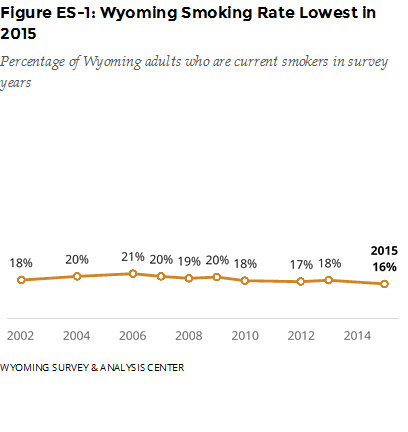 The adult smoking rate has shown a modest but steady decrease since 2006 (Figure ES-1).
The adult smoking rate has shown a modest but steady decrease since 2006 (Figure ES-1).
Preventing Initiation
About two thirds of those who have ever smoked a whole cigarette smoked their first whole cigarette when they were younger than 18. Almost one third smoked a whole cigarette for the first time between the ages of 18 and 24 (Figure ES-2).
Eliminating Exposure to Secondhand Smoke
Few Wyoming adults were exposed to secondhand smoke while in indoor public places (13%); more were exposed in outdoor public places (38%). Overall, 43% of adults were exposed to secondhand smoke while in an indoor or outdoor public place.
The majority of Wyoming adults supported smokefree indoor air laws for workplaces, restaurants, and casinos and clubs. About half supported a smokefree indoor air law for bars (Figure ES-3).
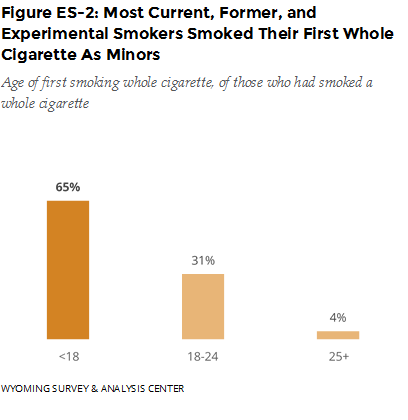
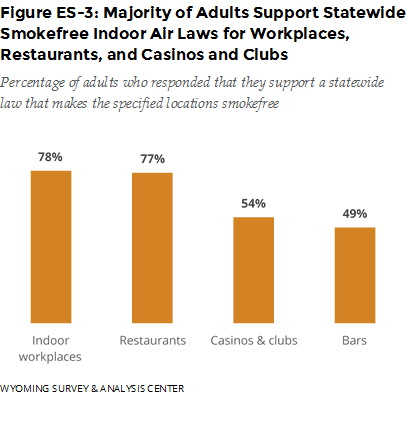
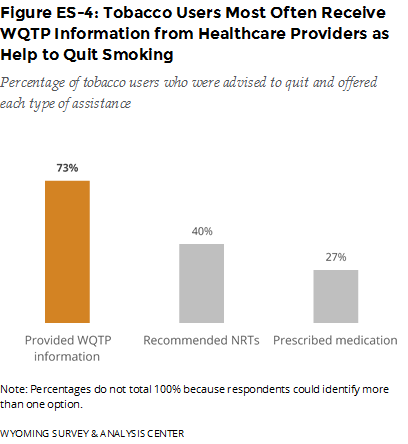 Promoting Quitting
Promoting Quitting
In 2015, 63% of tobacco users who were advised to quit were also offered assistance to quit from their healthcare providers. Of this group, 73% received information about the Wyoming Quit Tobacco Program (WQTP) from their healthcare providers (Figure ES-4).
Eliminating Disparities
The 2015 overall adult smoking rate in Wyoming was 16%. The 2015 ATS data show that certain groups are disparately affected by the health burdens of tobacco use:
- Native Americans (30% smoking rate)
- Those with less than a high school education (40% smoking rate)
- People who identify as LGBT (29% smoking rate)
- Young to middle-aged adults (20% smoking rate among 18–34-year-olds and 23% among 45–54-year-olds)
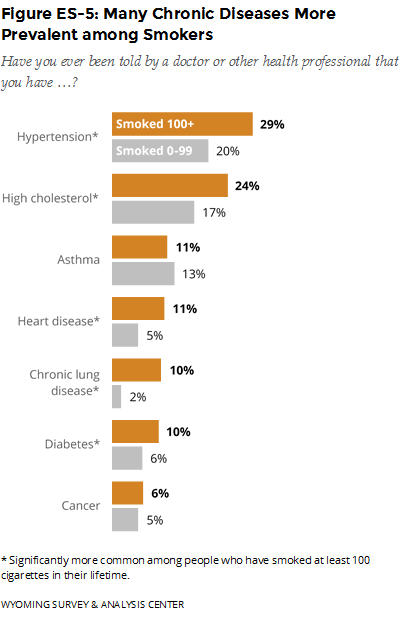 Health Consequences
Health Consequences
Based on self-report data, many chronic diseases are significantly more common among Wyoming adults who have smoked at least 100 cigarettes compared to those who have not (Figure ES-5).
Conclusions
The Wyoming smoking rate among adults has declined steadily since 2006. Persistent state and federal tobacco prevention efforts that help prevent smoking initiation and help people quit are likely to maintain that downward trend. This will, over time, reduce the economic and healthcare costs of smoking in Wyoming.

